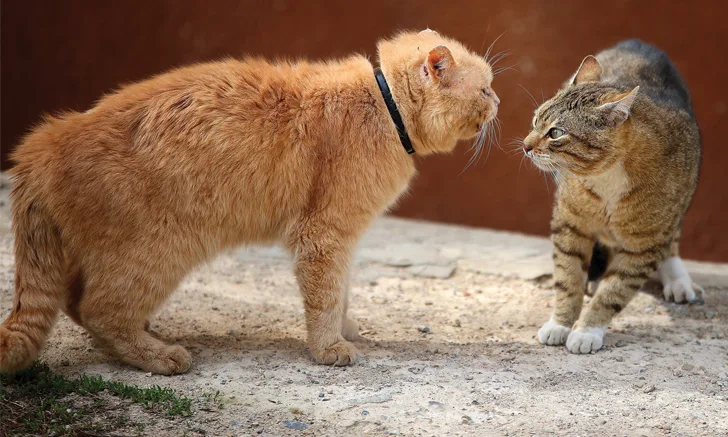Fighting & House Soiling in Cats
Debra F. Horwitz, DVM, DACVB, Veterinary Behavior Consultation

Resistant elimination problem behavior may be linked to undiagnosed ongoing social issues in a multiple-cat home. These issues may present as aggressive encounters but are often more covert and therefore often not linked by owners to house soiling behavior.
Understanding Feline Social Behavior
Cats should not be considered asocial, as they often live in matrilineal social groups (ie, with related female and juvenile male cats). A cat will form attachments to certain individuals within its group and actively avoid others.1 However, feline temperaments can vary from sociable, confident, and easygoing to timid, shy, and unfriendly; they may also be active and aggressive.2
Related Article: Educating Clients on Kitten Behavior
In the average companion cat household, the caregivers create the social groups; however, these groups may not always be compatible and may create social tension among some group members. When compatibility is an issue or when space is unequally shared, difficulty accessing food bowls, litter boxes, and resting areas can result in fighting and/or house soiling.3 Another study has identified correlation between agonistic interactions away from food and the ability to control interactions at the food level.4
Treatment At a Glance
Feline Communication
Understanding feline communication can help determine whether social issues exist:
Tail carried high and upright over back with ears erect: The cat is calm and may be investigating a new situation (eg, greeting an individual).
Hanging tail with ears forward5: The cat is relaxed.
Ears down and to the side, possibly with tail twitching: This indicates aggressive arousal.
Crouching or rolling over with ears back: The cat is inhibited.
Hissing with ears flattened to head: The cat is frightened.
Tactile communication occurs among compatible cats through lying together, rubbing against one another, grooming, and touching noses.5 Chasing and overtly aggressive threats (eg, growling, hissing, biting) may not be consistently evident. Covert threats may include blocking access to locations, staring, or supplanting. Cats displaying submissive behavior will crouch, turn the ears downward, and avoid the situation.6
Related Article: Feline Housesoiling
History
Many useful resources provide information about obtaining a standard house soiling history.7 Not all problematic social interactions are obvious to owners, so additional questions are often needed, such as:
When do you see all your cats in the same room? If the answer is “never” or “rarely,” a cat may have restricted household access.
Do 1 or more cats spend all their time in a single location? If the answer is “yes” and no resources are present in that area, the chance of house soiling may increase.
Does a cat block another cat from moving around the house? An affirmative answer suggests that a cat may not be allowed access to the litter box and therefore is forced to eliminate in another area.
Do you hear or see evidence of cats fighting? Fighting may only occur when owners are asleep or out of the home and may not be obvious.
Where are the litter boxes, food bowls, and resting areas? Multiple litter boxes in a single location are considered a single toileting area.
Treatment Options
There should be multiple litter boxes, food and water bowls, and resting areas in a multiple-cat household. These should be spread throughout the environment to accommodate the habits and access of the various cats. For example, some cats may have access only to certain household areas; if resources do not exist in those areas, anxiety and house soiling may result.
Paying proper attention to social interactions in the home may help resolve persistent house soiling.
Litter box size and cleanliness are always crucial, but particularly so when multiple cats share a litter box. Research has suggested that cats prefer clumping litter materials (rather than clay materials) and larger boxes.8,9 Fecal material and urine clumps must be removed daily and the entire box must be completely emptied, washed, and refilled every 10 to 14 days.
Related Article: Managing Feline Aggression
When intercat aggression is a component of house soiling problems, a multimodal approach is needed. This may include temporary separation of fighting cats, behavior modification exercises to reintroduce cats, pheromones, and possibly medication.10 Structured introductions may be useful to create harmony. Introductions may be accompanied by food or play so that pleasant things are associated with each cat’s presence. It may also be helpful for the aggressor to wear an approved cat collar with a large bell to forewarn of its approach and allow a potential victim to escape.10,11
In severe cases, medication may be necessary.
Pheromone therapy can be used to diminish fear and anxiety that may contribute to ongoing aggressive encounters. In severe cases, medication for both the victim and the aggressor may be necessary.10
Paying proper attention to social interactions in the home may help resolve persistent house soiling.